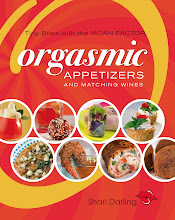
The shape of a wine glass alters the aromas and flavours of a wine. Make sure the rim is more narrow than the bowl. The Riedel glass on the left is well shaped and will enhance the character of the wine. The glass on the right is inferior.
After sitting down, place the napkin on your lap. As the host you are responsible for ordering the wine. Make sure the waitperson has handed you both the menu and wine list. Since you’ve already ordered Champagne for your guests, there’s no need to suggest aperitifs. If you have not requested a bubbly, ask your guests if they would enjoy an aperitif.
Remember, you want your guests to consume enough alcohol to enjoy themselves and to pair with their cuisine, but you must also ensure they are sober upon leaving the restaurant and getting into their vehicles.
Listen intently when your guests are ordering their main entrée. If you feel there are far too many cuisines being ordered, such as in weight and complexity of flavours, then suggest everyone enjoy individual glasses of wine. An entrée highlighting East Indian or Thai flavours offers a completely different taste profile than a steak stuffed with brie and wrapped in bacon. Both entrees demand specific styles of wines. Hot and spicy dishes require a wine with tropical flavours and sweetness, yet steak with cheese and bacon demands a big, fabulous red with good structure.
You will be the one expected to test the wine. The waitperson or sommelier will show you the label. Read the label. Be sure to read the name of the winery, the style (Bordeaux) and/or grape variety (Cabernet Sauvignon) and most definitely the vintage date. The same wine can vary in quality and price from year to year.
If you’re planning on entertaining clients, employees, family or friends this summer in a restaurant setting, it’s always handy to brush up on your etiquette, especially if you’re ordering wine.
I think it’s important to choose a restaurant that creates an experience rather than serves a meal, one with table cloths, linen napkins and well shaped wine glasses.
I think it’s important to choose a restaurant that creates an experience rather than serves a meal, one with table cloths, linen napkins and well shaped wine glasses.
Nothing is more infuriating to me than paying top dollar to discover that my dinner plate is set directly on a naked table beside a wine glass purchased from the Dollar Store and an accompanying paper napkin that threatens to give me paper cut lips.
If you’re a wino like me, you may want to choose a restaurant with a particular theme, such as a steak house, one that also possesses a decent wine cellar and wine list to accompany its distinct menu.
If you’re a wino like me, you may want to choose a restaurant with a particular theme, such as a steak house, one that also possesses a decent wine cellar and wine list to accompany its distinct menu.
I like to make sure that I can order a fabulous bottle of wine, one that all my guests can enjoy with their similar entrees. Chiado Restaurant in Toronto at 864 College Street Toronto, ON M6H 1A3, is case in point. This authentic Portuguese gem does not serve meals, but rather creates heightened culinary experiences. Their extensive fish selection is well suited to the Portugese only wine list. This restaurant gets 10 on the Moan Factor Scale!
To make a great impression, consider phoning the sommelier or restaurateur a head of time to make a reservation for a specific time. And if applicable, request a particular table within the restaurant, one with the best view. Also request a bottle of sparkling wine or Champagne be set on the table immediately upon your arrival. 

After sitting down, place the napkin on your lap. As the host you are responsible for ordering the wine. Make sure the waitperson has handed you both the menu and wine list. Since you’ve already ordered Champagne for your guests, there’s no need to suggest aperitifs. If you have not requested a bubbly, ask your guests if they would enjoy an aperitif.
Remember, you want your guests to consume enough alcohol to enjoy themselves and to pair with their cuisine, but you must also ensure they are sober upon leaving the restaurant and getting into their vehicles.
Listen intently when your guests are ordering their main entrée. If you feel there are far too many cuisines being ordered, such as in weight and complexity of flavours, then suggest everyone enjoy individual glasses of wine. An entrée highlighting East Indian or Thai flavours offers a completely different taste profile than a steak stuffed with brie and wrapped in bacon. Both entrees demand specific styles of wines. Hot and spicy dishes require a wine with tropical flavours and sweetness, yet steak with cheese and bacon demands a big, fabulous red with good structure.

You will be the one expected to test the wine. The waitperson or sommelier will show you the label. Read the label. Be sure to read the name of the winery, the style (Bordeaux) and/or grape variety (Cabernet Sauvignon) and most definitely the vintage date. The same wine can vary in quality and price from year to year.
The sommelier or waitperson will open the wine in front of you. After opening the bottle, the server will then put the cork in front of you. You may have noticed some people smelling the cork. You do not need to do this. Just feel it instead. The level of moisture in the cork may be an indication of how the wine has been stored. If the cork is dried out, this may be a sign that the bottle has been stored upright, rather on its side, thereby allowing air inside the bottle and causing the wine to oxidize – aging before its time. Young wines, however, may have dry corks because they have just been bottled. If the cork is gummy, this may be a good indication that the wine has oxidized. Cork taint accounts for less than 3 percent of all wines. So, your chance of getting one is slim.
The server will then pour an ounce of wine into your glass. Your job is to swirl the wine, smell it and taste it. If you’re unsure as to what to smell, just concern yourself with the taste. If the wine tastes pleasant, nod and let the server then fill your guests’ glasses first; yours last. If the wine’s taste reminds you of cooked fruit – the kind you put into a pie – then the wine may very well be oxidized. If the cork is gummy and the wine taste liked cooked fruit, ask for another bottle of wine.
The server will then pour an ounce of wine into your glass. Your job is to swirl the wine, smell it and taste it. If you’re unsure as to what to smell, just concern yourself with the taste. If the wine tastes pleasant, nod and let the server then fill your guests’ glasses first; yours last. If the wine’s taste reminds you of cooked fruit – the kind you put into a pie – then the wine may very well be oxidized. If the cork is gummy and the wine taste liked cooked fruit, ask for another bottle of wine.
Don’t be shy to send it back and order a new bottle of wine. The restaurateur will place the cork back into the bottle and return it to its source for a replacement. (Remember that you cannot drink an entire glass before requesting the wine be removed from the table.)
If you agree with the wine, nod to the sommelier. He/she will then pour the wine, beginning with your guests sittingto your right. You will be serves last.
In a busy and crowded restaurant it may take a while for the wait person to return to top up the wine glasses. Take it upon yourself to fulfill this task. Pour wine into all your guests’ glasses before your own. Pour the same amount into each glass despite how slowly or quickly your guests are sipping.
A new bottle of wine deserves clean wine glasses. You are paying a premium price for this beverage and so deserve to have clean glasses for each product.
At the end of the meal offer dessert to your guests with tea or coffee. The additional fat will absorb alcohol. Sit and relax for a while before paying the bill. Your guests will feel obligated to stay seated. Additional alcohol-free time is the only remedy to reduce the alcohol levels in the blood.
If you agree with the wine, nod to the sommelier. He/she will then pour the wine, beginning with your guests sittingto your right. You will be serves last.
In a busy and crowded restaurant it may take a while for the wait person to return to top up the wine glasses. Take it upon yourself to fulfill this task. Pour wine into all your guests’ glasses before your own. Pour the same amount into each glass despite how slowly or quickly your guests are sipping.
A new bottle of wine deserves clean wine glasses. You are paying a premium price for this beverage and so deserve to have clean glasses for each product.
At the end of the meal offer dessert to your guests with tea or coffee. The additional fat will absorb alcohol. Sit and relax for a while before paying the bill. Your guests will feel obligated to stay seated. Additional alcohol-free time is the only remedy to reduce the alcohol levels in the blood.





No comments:
Post a Comment